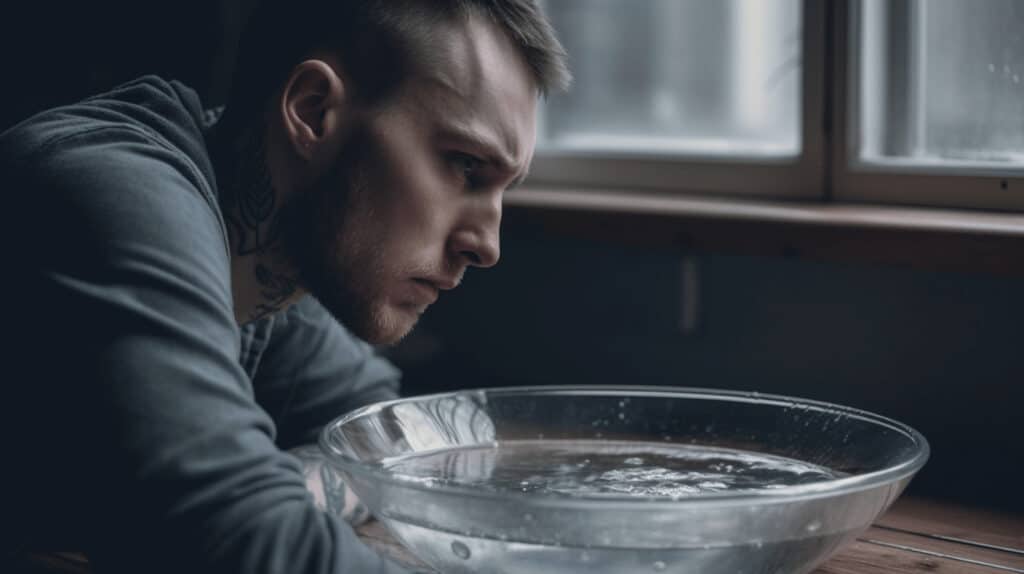Ever wondered why plunging into icy waters or soaking in the warmth of a sauna feels surprisingly exhilarating? Whether it’s the shock of cold water or the embrace of steamy heat, these ancient wellness practices do more than just stimulate your senses.
They’re gateways to a myriad of health benefits that touch every aspect of our being.
These temperature-based therapies offer multiple benefits for the mind and body, from cardiovascular and metabolic health to improved mood and reduced stress levels.
Read on to explore the health benefits of ice baths and saunas. Join us as we demystify how these practices can transform your health, mood, and resilience.
Ice Baths – Embracing the Cold
Cold Plunges: A Chill That Thrills Your Health

Ice baths, also known as cold plunges or cryotherapy, have been making waves for their remarkable ability to speed up recovery, ease muscle aches, and boost your health from head to toe.
Imagine immersing yourself in water temperatures flirting with the 50 degrees Fahrenheit for 10 -15 minutes, and emerging not just alive, but invigorated, with reduced blood pressure and a surge in dopamine levels. This isn’t just an athlete’s secret weapon; it’s a science-backed strategy for anyone seeking a refresh for their body and mind.
Cold water therapy is suggested to decrease cortisol levels by up to 30% and increase dopamine levels by 250%.
The immediate constriction of blood vessels and the subsequent rush of blood upon warming up work together to fight inflammation, accelerate recovery, and flood your system with a euphoric wave of endorphins. Even a brief encounter with the cold can have lasting effects on your well-being
Some ice-bath enthusiasts, such as many professional athletes, vary the temperature, duration, and frequency of their ice baths to fit curated treatment and recovery programs.
Looking For Therapy? Start Healing Today. Call Now To Get Started!
212-960-8626How many ice baths a week should you take?
Finding Your Cold Therapy Sweet Spot
Diving into the world of cold therapy is an exhilarating journey that raises an important question:
How many ice baths a week should you take to truly reap the rewards without overdoing it?
The adventure starts with the simpler, less intimidating approach of cold showers, gently introducing your body to the bracing chill.
As you grow more accustomed to the cold’s sharp embrace, the magic number appears to be 1 to 3 ice baths per week. This frequency strikes the perfect balance, allowing you to tap into the cold’s exhilarating benefits while giving your body the time it needs to recover and adapt.
Consistency is your best ally in this journey, coupled with a keen awareness of how your body responds to each icy encounter.
Just like with any habit, starting slowly (perhaps just once a week and slowly increasing) is the way to go.
Using smart wearable devices, like the Oura ring, the Apollo or the Apple Watch, can be incredibly insightful, helping you to precisely gauge the impact of your ice baths and adjust your routine for optimal health benefits.
Each plunge is an opportunity to invigorate your body, sharpen your mind, and, yes, sometimes question your sanity—all in the name of wellness.
When it comes to taking ice baths, determining the best frequency for your body and lifestyle can depend on various factors. Start by taking cold showers and gradually increasing your exposure from 1 to 3 minutes. This will help your body adapt to the cold.

Why does temperature therapy help with stress?
The Science Behind Temperature Therapy and Stress Relief
Temperature therapy has been shown to have an impact on stress reduction. For example, subjecting the body to extreme cold or heat can stimulate the release of endorphins and trigger a mental adaptation response that can help the body manage stress more effectively.
Cold and heat therapies, such as ice baths and sauna sessions, aid in recovery and stress reduction. Alternating between cold and heat can improve blood circulation through dilation of blood vessels, reduce inflammation, and promote muscle relaxation and repair.
Ice baths cause blood vessels to constrict, reducing inflammation and muscle soreness, while heat therapy promotes vasodilation, enhancing blood flow and nutrient delivery to the muscles.
A dance between the extremes of hot and cold, plays a harmonious role in stress management. The dynamic interplay between cold plunges and sauna sessions teaches the body to swiftly and effectively respond to stressors, ultimately reducing chronic stress levels and enhancing mental well-being.
Moreover, short bursts of intense exercise, combined with cold and heat therapies, optimize these benefits.
What are ice baths good for?
Unlocking the Multifaceted Benefits of Cold Plunges
ce baths are not just for the bold-hearted; they’re a gateway to a plethora of health benefits. By inducing vasoconstriction, our blood vessels constrict and our overall circulation slows. This process enhances recovery, reduce muscle soreness, limit the buildup of waste products in the muscles, provide temporary pain relief and improve cardiovascular efficiency. Vasoconstriction
Additionally, cold plunges kickstart the body’s immune response, leading to improved resilience against illnesses. Ice baths stimulate the release of endorphins, and improve circulation once someone warms up, which can aid in the healing and recovery process via improved blood flow.
Even a cold shower can have a healthy effect as the body speeds up its metabolic rate and activates its immune system, which increases the amount of white blood cells in the bloodstream.
It is important to consult with a healthcare professional before incorporating cold water immersion, as it may not be suitable for everyone, especially those with certain medical conditions such as Raynaud’s disease.
Proper timing, duration, and gradual cold exposure are key to ensure safety and maximize the benefits of ice baths.
From accelerating muscle recovery and reducing inflammation to enhancing immune system function and promoting better sleep, the advantages of cold water immersion are plenty. Essentially, ice baths are a holistic tool for physical and mental rejuvenation.
Mental Health Benefits of Ice Baths
Cold Therapy: A Refreshing Boost for Mental Health
Exploring the depths of cold water immersion reveals a remarkable effect on mental health, alongside its physical benefits. The mental uplift from diving into the cold is undeniable.
Cold immersion therapy has been linked to improved mood, better energy levels, increased resilience to stress, better insulin sensitivity, mental toughness, and a reduction in many symptoms of anxiety and depression.
Ice baths trigger the release of endorphins, the body’s feel-good chemicals that act as natural mood lifters and pain blockers. This endorphin surge can induce a state of euphoria and deep relaxation, effectively countering symptoms of anxiety, stress, and depression. Moreover, the cold’s stimulation of norepinephrine – a critical neurotransmitter for focus and anxiety reduction.
Highlighting the potency of cold therapy, studies reveal astonishing increases in neurotransmitters responsible for our well-being. A mere 20 seconds in ice-cold water can dramatically elevate norepinephrine levels (as much as 300 percent), proving that significant benefits can be attained without prolonged exposure.
While concerns exist regarding the stress hormones like cortisol that cold exposure can elicit, these effects are nuanced. Engaging in cold plunges judiciously, ideally no more than once or twice a week, can mitigate these concerns while maximizing the mental health benefits. Such a routine not only bolsters stress resilience but also trains the body and mind to navigate stress more adeptly over time.
This resilience, forged in the icy waters of an ice bath, extends its benefits far beyond the immediate post-plunge exhilaration. It cultivates a mental fortitude that enhances daily stress management, reduces depressive symptoms and fosters a more joyful, balanced mood.
Embracing the cold, it turns out, strengthens not just the body but the mind as well, preparing us to better withstand life’s ups and downs.
Through regular cold exposure, we tap into a primal ability to adapt and thrive under stress and enhancing our overall mental health. The cold, it seems, is not just a physical therapy but a profound mental health hack, inviting us to discover our inner strength and resilience in the face of life’s inevitable stresses.
Begin your healing journey today. Call now to start your therapy!
212-960-8626How long should you expose yourself to the cold?
In many recovery settings, a common practice is to stay in an ice bath for approximately three minutes. This duration is often used by professional athletes and sports teams for recovery purposes, but each individual’s tolerance to cold varies.
This duration, while not set in stone, serves as a practical starting point for many, balancing the benefits of cold exposure with comfort and safety.
It’s essential to listen to your body and avoid staying in the ice bath longer than you can handle.
Embracing a gradual approach to cold exposure is advisable. Begin with shorter durations, incrementally increasing only as your comfort with the cold grows.
It is equally important to warm up prior to your body’s immersion in a cold plunge. This helps reduce the risk of hypothermia among others.
Prolonged exposure to extremely cold water can lead to hypothermia or other adverse effects. There is no need to overdo things in order to reap the benefits from cold exposure. A slow and steady approach is the best way to go.
What about an ice bath for your face?

If you’re not in the mood for dipping your whole body in a cold bath or a cool shower, you might utilize cold therapy for your face. An alternative approach is the “ice face” technique, which involves submerging your face in ice water. This method harnesses the high concentration of nerves in your face, making it an ideal target for the stimulating effects of cold water. It’s a simple, cost-effective strategy for experiencing the invigorating benefits of cold therapy right at home.
To get started with the ice face technique, you’ll need just a few simple items: water, ice, and a shallow pan. Freeze water in the pan until solid, then add a bit more water to cover the ice.
Find A Therapist Today. Call now to start your healing journey!
212-960-8626The next step is both exhilarating and straightforward: take a deep breath, and immerse your face into the chilled water. Initially, aim to keep your face submerged for a brief period like 20 seconds, listening to your body’s response to the cold. As your comfort level increases, you can extend the duration gradually.
For those looking to prolong their ice face bath, consider using a snorkel to breathe comfortably while your face remains submerged.
Engaging in this practice before bedtime can lower your body temperature, potentially aiding in falling asleep faster and achieving deeper sleep. It is advisable to start slowly. Pay attention to how you feel immediately after exposing your face to the cold.
Do you feel a sense of calm wash over you, or perhaps a surge of energy?
After each session, take a moment to reflect on how you feel. Monitoring these changes can help you tailor the practice to your needs, maximizing the benefits of the ice face technique.

The Power of Saunas
What Are Hot Saunas Good For?
The enchanting warmth of a sauna isn’t just a luxurious escape; it’s a time-honored tradition steeped in health benefits used for millennia. From the dimly lit, wood-paneled rooms of local gyms and spas, saunas invite us into a world where heat works magic on the body and mind. But what exactly makes hot saunas a cornerstone of wellness?
The Multifaceted Health Benefits of Sauna Use:
Beyond their well-known ability to induce deep relaxation, hot saunas trigger potent detoxifying effects. The high temperatures in saunas induce sweating, which helps remove toxins from the body, improves cardiovascular health, and aids in muscle recovery.
One of the most intriguing effects of regular sauna sessions is the activation of heat shock proteins (HSPs) within our cells. These powerful proteins are the guardians of cellular integrity, repairing damaged cells and shielding them from the stresses of everyday life. Their activation through sauna exposure is akin to giving your cells a protective armor, reducing oxidative stress and bolstering cellular resilience.
Sauna-induced activation of HSPs can help restore damaged cells, reduce oxidative stress, and enhance overall cellular resilience through oxygenated blood.
But the magic of saunas doesn’t stop at the cellular level. The warmth experienced during a sauna session causes blood vessels to expand, boosting blood flow throughout the body. This enhanced circulation delivers oxygen and essential nutrients more efficiently to muscles and organs, simultaneously aiding in the elimination of metabolic byproducts. The result? Alleviated muscle tension, improved insulin sensitivity, and an overarching sense of physical and mental vitality.

Saunas and Cardiovascular Health: A Heart-Healthy Habit
Embracing the heat of a sauna is surprisingly akin to engaging in moderate-intensity exercise. As your heart rate and cardiac output increase, so does your body’s endurance and cardiovascular strength—minus the exhaustive physical exertion. Regular sauna use is not just a relaxing ritual but a proactive step towards a healthier heart and improved endurance.
Deep Relaxation for Deeper Sleep
Perhaps one of the most cherished benefits of sauna therapy is its ability to usher in a state of profound relaxation, setting the stage for a night of deep, restorative sleep. The persistent heat helps regulate your body’s internal clock, promoting a more regular sleep-wake cycle.
From detoxification and cellular repair to cardiovascular health and sleep enhancement, the sauna is a testament to the enduring power of heat therapy.
The next time you step into the warm embrace of a sauna, remember you’re not just indulging in a moment of relaxation—you’re participating in a time-honored tradition of holistic healing.
Sauna and mental health (sauna benefits for depression and anxiety)
The serene warmth of a sauna offers more than just physical benefits; it’s a potent sanctuary for mental wellness, with remarkable efficacy in soothing symptoms of anxiety and depression. The enveloping heat and gentle humidity act as a catalyst for profound psychological healing, drawing parallels to the refreshing chill of ice baths in their ability to enhance mood and instill a deep sense of calm.
Regular sauna sessions can provide mental health benefits including:
Inducing Relaxation Through Heat:: When you enter a sauna, the high temperature and dry heat of the environment (if you’re using Finnish saunas) stimulates your body’s thermoregulatory system. The rising core body temperature in response to the sauna’s heat elicits a natural relaxation response. This physiological shift is accompanied by a release of endorphins, the body’s intrinsic happiness enhancers. These mood-boosting chemicals flood your system, elevating your spirits and promoting an overall sense of well-being.
Mastering Stress with Cortisol Regulation: The sauna’s warmth does more than relax the body; it acts directly on the biochemical level to regulate stress hormones, including cortisol. By moderating the levels of this stress-associated hormone, saunas facilitate quicker, more efficient recovery from the day’s tensions. Lower cortisol levels are directly linked to reductions in anxiety and significant improvements in mood. When paired with mindfulness practices like deep breathing, the sauna experience becomes a potent mental health practice.

Infrared Saunas or Traditional Saunas?
When exploring the world of saunas, a pivotal question emerges: should you immerse yourself in the traditional sauna experience or venture into the modern infrared saunas? Each type offers a unique approach to harnessing the power of heat for health and relaxation, yet they operate on distinct principles that cater to different preferences and wellness goals.
Infrared saunas mark a departure from traditional sauna practices by using infrared heaters to emit a spectrum of infrared light. This innovative approach directly warms your body, penetrating deeply into tissues with radiant heat, without significantly increasing the air temperature around you. This direct method of heating offers a gentler, yet profoundly effective sauna experience.
One of the standout features of infrared saunas is their efficiency. Infrared saunas are faster acting, require less heat and a shorter exposure to reap the benefits.
How long does it take to benefit from a sauna session, and how often should you do them?
Mastering Sauna Sessions: Frequency, Duration, and Health Impact
To harness the full spectrum of health benefits offered by sauna sessions, understanding the optimal frequency and duration is crucial.
Frequency for Maximum Benefits:
The pathway to significant long-term health improvements lies in the consistency of your sauna routine. While individual preferences and health backgrounds play a role in determining the ideal frequency, research and expert opinions point towards a sweet spot for most people.
Optimal Sauna Use for Heart Health and Longevity:
- Regular Use: For overall health maintenance, including stress relief and detoxification, engaging in sauna sessions 2-3 times per week is shown to be effective.
- Cardiovascular Benefits: More frequent sessions, as often as daily, have been linked to substantial heart health advantages. Echoing the guidance of Dr. Andrew Huberman, aiming for 2-3 to up to 7 sauna sessions weekly can significantly reduce the risk of cardiovascular diseases. Studies show that using the sauna 2-3 times per week reduces the risk of cardiovascular events by 27%, with an increase to 4 times weekly doubling the protective effect.
- Longevity and Intensive Exposure: Interestingly, repeated sauna exposure on the same day adding up to over 60 minutes in extreme heat shows signs that it promotes longevity by activating the heat shock protein discussed above. To benefit from this longevity hack, routine sauna exposure is not necessary, but same-day long sauna exposure is.
To recap, for enhanced longevity and detoxification, opt for longer sauna sessions on the same day. To boost cardiovascular health, aim for 4 to 7 sauna sessions weekly. This tailored approach allows you to align your sauna usage with your specific health goals effectively
The cornerstone of a beneficial sauna practice is listening to your body, staying hydrated, and adjusting your routine as needed to ensure each session is a rejuvenating, safe experience.

The synergy of ice baths and saunas
The benefits of the sauna and ice-bath combo are numerous. Harnessing the power of both ice baths and saunas creates a potent synergy that amplifies the individual benefits each can offer.
Alternating between hot and cold temperatures enhances circulation, reduces inflammation, and promotes overall vitality. Because ice baths and saunas provide many of the same health benefits, though they use vastly different mechanisms, combining them helps to multiply these effects.
It’s worth pointing out that cold exposure reduces inflammation by constricting your blood vessels and thus causing a decrease in blood flow. On the other hand, heat exposure dilates blood vessels, increasing blood flow and inflammation (at least in the short term). However, by enabling the body to send more oxygenated blood to the inflamed area, heat exposure speeds up the healing processes, which leads to reduced inflammation over time.
The reason why the benefits of both therapy forms are synergistic (instead of canceling each other out) is because humans have evolved to adapt and become more resilient when exposed to extreme circumstances on opposing sides of the spectrum. By alternating between the cold of ice baths and the heat of saunas, we tap into this primal adaptability, triggering a robust physiological response that leads to improved health and well-being.

Ice Bath or Sauna First? Better to do Ice Bath After Sauna
Should you do the ice bath or a hot sauna session first? Overall, it’s better to do an ice bath after a sauna session, not before.
Why Ice Bath After Sauna
The sauna experience elevates your core body temperature, dilates your blood vessels, and boosts circulation. This preparatory phase primes your body for the shock of cold exposure. Taking an ice bath before warming up in the sauna could counteract the warming effects, as the sudden cold constricts your blood vessels, potentially dampening the sauna’s circulatory benefits.
Conversely, transitioning from the warmth of the sauna to the chill of an ice bath takes advantage of the body’s natural heat adaptation mechanisms. This sequence—first heating then cooling—intensifies the body’s response, improving heat tolerance and fostering physiological resilience. The stark contrast between hot and cold exposure not only shocks the system into adaptation but also maximizes the health benefits of both practices.
Strategic Benefits Based on Goals:
- For Stress Response: If enhancing your body’s ability to handle stress is a priority, following up a sauna session with an ice bath can amplify this effect. The heat-to-cold transition tests and strengthens your body’s stress response, enhancing mental and physical resilience.
- For Energy Levels: Ending with an ice bath can invigorate your senses and elevate your energy levels, counteracting the sauna’s tendency to induce relaxation, especially at higher temperatures.
- For Blood Flow and Circulation: Although the preferred sequence is sauna followed by ice bath, starting with cold exposure can still benefit those specifically targeting improved circulation, as the cold plunge followed by sauna warmth may have the greatest blood flow impact.
The Nordic Cycle: A Path to Enhanced Well-being
This practice of alternating between heat and cold, known as the Nordic cycle, not only boosts circulation and immune function but also contributes to fat burning, stress reduction, and improved mood and sleep quality. It embodies a holistic approach to health, encouraging the body to adapt to extremes and emerge stronger.
Embracing the sauna and ice bath sequence is about more than just enduring temperature extremes; it’s a journey towards holistic health and resilience. As with any wellness practice, listening to your body’s signals, maintaining a balanced diet, ensuring adequate rest, and managing stress are crucial to reaping the full benefit.

Is sauna bathing or cold plunging better if your goal is to improve mental health?
When considering sauna bathing and cold plunging for mental health improvement, both practices offer unique pathways to enhancing brain chemistry and overall emotional well-being. Each method stimulates the brain in different ways, leading to an improved mood and a state of calm.
Sauna increases the release of endorphins, sometimes referred to as ‘feel-good’ hormones, which naturally elevate mood and provide a sense of happiness and relaxation.
On the flip side, cold plunging challenges the body with a brisk shock, activating a rush of adrenaline and endorphins that can lead to a vibrant, energized state. Beyond the immediate invigorating effects, cold water immersion is known to stimulate the production of cold shock proteins. These proteins not only have neuroprotective benefits, potentially safeguarding against neurodegenerative diseases like Alzheimer’s, but also contribute to improved brain health and resilience.
Given these distinct benefits, cold plunging may have a slight edge, particularly for those seeking not just mood enhancement but also long-term neuroprotective effects. The stimulation of cold shock proteins suggests a unique advantage for cold water immersion in bolstering mental well-being and cognitive protection.
Ultimately, the choice between sauna bathing and cold plunging might come down to personal preference, specific mental health goals, and how one’s body and mind respond to heat versus cold therapy. Incorporating either or both practices into a wellness routine can be a powerful step toward improved mental health and emotional balance.
Conclusion:
Integrating the elemental forces of ice baths and heat therapy into your self-care routine unlocks a myriad of long-term health advantages. These natural therapies, steeped in simplicity yet profound in effect, extend a holistic invitation to wellness, offering everything from stress reduction and mood enhancement to accelerated recovery and cardiovascular health improvement. Beyond their individual benefits, the strategic combination of these therapies multiplies their impact, guiding you toward a state of enhanced well-being and tranquility.
Ready to overcome stress and anxiety? If you’re seeking to alleviate stress, conquer anxiety, and embrace a journey of emotional growth, our team of therapists is here to guide you.
Connect with our therapists today and begin your journey to greater emotional well-being and personal growth.
Don’t let stress and anxiety dictate your life’s course. Reach out today to embark on a transformative path to emotional well-being and personal development. Start your wellness journey by calling us at 212-960-8626 or by filling out our contact form.
Your first step toward a more peaceful, fulfilling life is just a conversation away. Let us be your partners in wellness, guiding you to a brighter, healthier future.
Looking For Therapy? Start Healing Today. Call Now To Get Started!
212-960-8626

